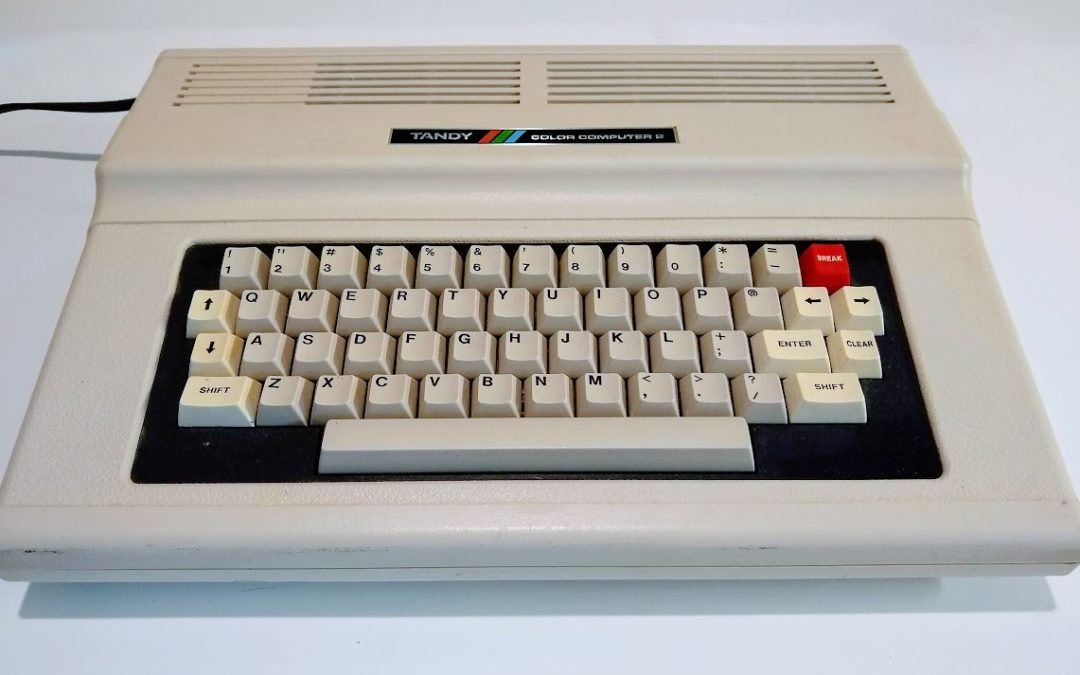It Takes Two, CoCo 2 That Is!
A while back, I wrote this series of articles for Retrogaming Times Monthly, hoping to get the CoCo more exposure. Then the magazine wemt thru changes… away. Hoever, based on my love of the TRS-80/Tandy Color Computer line, I’m reposting them here…..
The last previous article discussed the various models of what has now come to be called the Color Computer 1, or CoCo1, and its clones. The article series seemed to be fairly well received, however, things in my life at that time quickly spun out of control. There were numerous real-life problems that prevented the follow-up article, in which I had planned to discuss the next model, the Color Computer 2.
Suffice it to say, I was not happy about these events, or the effect they were having on my life. However, I’ve spent the last year trying to work thru them and get back to a point where I could start enjoying life and my various hobbies again – as well as devoting a lot of time to the things I had neglected for so long – my family.
The TRS-80 Color Computer 2
In September of 1983, Tandy/Radio Shack released another Color Computer; the Color Computer 2. The CoCo2 line has six distinct model numbers, and some of the models have an (A) and (B) version as well.
Before we get into the various models, I do need to stress one thing: all of these machines are at least 99.9% compatible with Color Computer 1 software and mostly compatible with Color Computer 1 hardware peripherals. The exception on the hardware side is that the CoCo2 does not generate or use 12vdc. Due to the lack of a 12vdc circuit, first generation floppy drive controllers will not work with a CoCo2. According to my info sources, these are the 26-3022 and 26-3029 floppy controllers. The rest of the floppy disk controllers work well with all CoCo models. Both of those controllers WILL work with your CoCo2 if you have a multi-pak interface, since it does supply the 12vdc the controllers require.
Like the CoCo1, all CoCo2’s have two joystick, one cassette and one serial (bit-banger) port. They also have a 20 position (40 pin) cartridge slot on the right side of the computer. This myriad of ports and cartridge slot, in conjunction with a 6-bit DAC, allow the CoCo2 to interface with the outside world in innumerable ways. Like the last generation white CoCo1, the first CoCo2 models also had the ‘melted’ but improved keyboard. There were NTSC and PAL versions of the CoCo2 as well. Below are the full technical specs:
General:
-
- First Released: 1983
- CPU: 8 bit 6809E
- Clock speed: 0.89 MHz
- Bus type: Tandy Proprietary
- Data bus width: 8-bit
- Address bus width: 16-bit
Memory:
-
- System board initially offered only 16K
- Maximum on system board 32k (early models) or 64K
- Maximum total memory 64K
- ROM: 8 kbytes, containing the standard version of Microsoft BASIC
- An optional upgrade to the full version of the Microsoft Color BASIC existed, pushing the ROM size to 16 kbytes
Ports:
-
- 40 pin bus connector/Cartridge connector for game cartridges and system expansion
- Two analog joystick connectors
- Tape player/recorder connector, 1500 baud interface
- RS-232 serial (bit-banger) port
- TV connector (RF modulator)
Video:
-
- 9 colors were available: The standard eight video colors plus orange
- The displayed colors had to be selected from two predefined four-color palettes for four-color modes, and two predefined two-color palettes for two-color modes
- No color switching was possible
- Special variations of display modes were possible, by exploiting the 6847’s flexibility
Audio:
-
- The CoCo II uses a 6-bit DAC (Digital-to-Analog Converter), controlled by the CPU
- This allows for 64 different volume levels, and quite a bit of fancy sounds (speech and other samples, for instance)
- But, since the DAC was under CPU control, sounds taxed performance quite a lot
Storage:
-
- Tape – at release
- Floppy – at release
- Hard disk and other mass storage – later
Operating System:
-
- Most CoCo 2s use version 1.2 of the Color BASIC ROM
- All Extended CoCo 2s use version 1.1 of Extended BASIC
- RS-DOS if equiped with a floppy drive
- OS-9 Level 1 also available with floppy systems
Enter the 26-3026 & 3027 (Made in America)
As stated above, the CoCo2 is compatible with the CoCo1. Really, the CoCo2 takes advantage of large scale integration of IC chips to lower the chip count, and reducing the footprint of the motherboard. So much so, in fact, the CoCo2’s case is roughly half the size of the CoCo1. When first introduced, there were only two versions of the CoCo2, both American made, and available from Radio Shack stores with the following catalog numbers:
26-3026 � 16k Color Basic (CB) listed price of $239.95 (Radio Shack) 26-3027 � 16k Extended Color Basic (ECB) listed price of $319.95 (Radio Shack)
First appearing in the October 1983 issue of Rainbow Magazine for sale at Computers Plus, at the time a very popular computer mail order company based in Littleton Massachusetts. They carried a complete line of Tandy/Radio Shack computers, hardware and software (my parents ordered my first CoCo from them). They advertised heavily in The Rainbow Magazine. In fact, they offered 16k and 64k CoCo2 with ECB for $245 and $305 the first month the CoCo2 was available.
In completely stock form, both machines were identical in every way, except the ROM version. There are two possible versions (and ‘A’ and ‘B’) for each catalog number. The 26-3027B board is shown below.
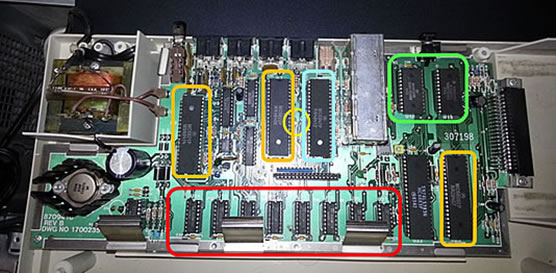
The eight 16 pin IC’s towards the bottom of the motherboard are the 4116C DRAM chips (circled in red) � note the socketed DRAM chips. Both catalog numbers could be upgraded to 64k by replacing these chips with eight 4164 DRAM chips; then soldering a small jumper to pads ‘W1’ (circled in yellow) to activate the 64k mode.
The main IC’s that make up a CoCo2:
-
- CPU – MC69B9E circled in orange, lower right
- ROM – ECB circled in green, upper right
- VDG – MC6847P circled in cyan, middle-right
- PIA’s – MC6821 & 6822 circled in orange, middle-left & left
- SAM – MC6883P not circled, 40 pin IC next to CPU
The Factory Upgrade 26-3127 (Made in America)
In the March 1984 issue of The Rainbow, Radio Shack began advertising a 64k ECB CoCo2, priced at $259.95. (Computers Plus had been selling the 64k upgraded CoCo2 since Fall 1983. As of this issue of The Rainbow, they were selling it for $210.00). This was the first 64k CoCo2 offered by Radio Shack.
Along with 64k came an ‘enhanced’ full travel keyboard, from Radio Shack, on a Color Computer finally These are identical to the 26-3027 computers except for the inclusion of 64k and the full travel keyboard. However, there IS one difference the DRAM chip are soldered directly to the motherboard as shown below, gone are the sockets that made it easy to upgrade the 26-3027. So, if you had to replace a DRAM chip for some reason, you had to cut out the old one.
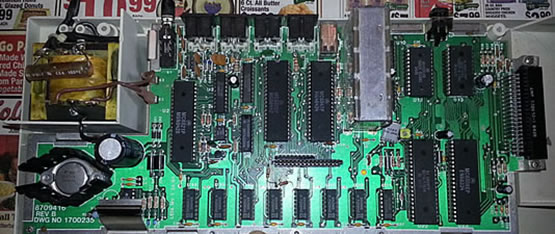
(26-3127 American built CoCo2 – very similar to the 26-3027 shown earlier – note the DRAM chips are not socketed.)
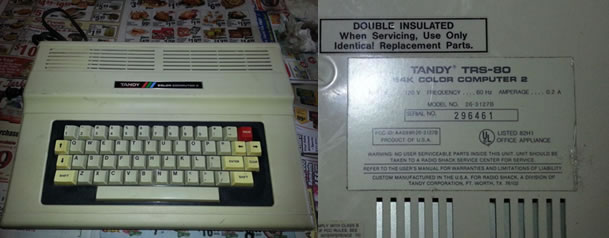
(Above are exterior pics of my American built 26-3217B)
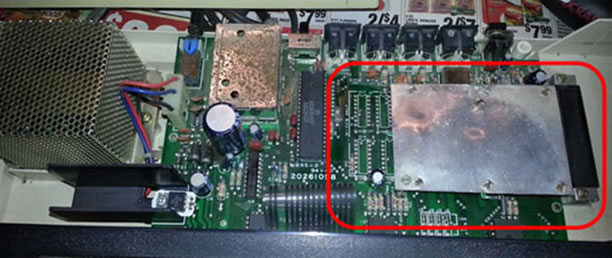
The area circled in red shows the installed 64k of DRAM. Note the covered area and missing IC’s. This model CoCo2 could have 64k installed either with a daughter card or directly on the motherboard. This board design is labeled 20261058.
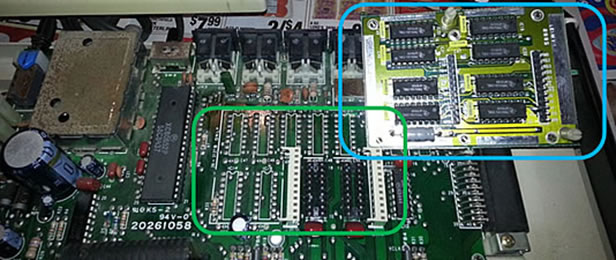
Also notable on this version are the white connectors. The daughter card plugs into these two connectors to provide access to the eight DRAM – 4164 – chips. Memory could also be provided by adding eight sockets directly on the motherboard (again, 4164’s) or two 4464 DRAM chips in the sockets between the two connectors.
Mine is an admittedly late model 26-3127B with a rather high serial number. Earlier version 26-3127B’s may be, and probably are, different.
The Korean CoCo Lines
There’s Much conjecture about the Korean made CoCo2’s; well, for one model anyway. I’ll get to that in a minute. With the exception of one board series, the Korean CoCo2’s were very different than the previous designs. Radio Shack catalog numbers list three models of the CoCo2 that were manufactured in Korea. Two of these had an ‘A’ and ‘B’ revision, while the third had only a ‘B’ revision.
The First Korean CoCo2: 26-3134& 26-3136
The first Korean CoCo2’s were 16k machines, and virtually every component on this motherboard is located differently from any of the American made units.
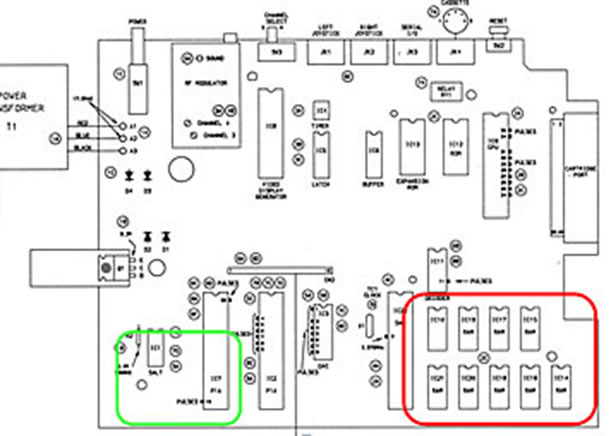
(Component placement according to Sam’s Computer Facts for a 26-313 4& 3136 CoCo2)
What’s the difference between the 26-3134 & 26-3136 models? Well, they are both 16k machines, both are upgradable to 64k by swapping out the 4116 DRAM chips (IC14 � IC21 circled in red above) with 4164 DRAMs. The difference is this: the 26-3134 is a Color Basic machine while the 26-3136 is an Extended Color Basic machine.
Below is a picture of my latest CoCo2 eBay acquisition. It is a 26-3134 Korean built CoCo2. The board number is 20461044. As you can see, the components are completely different from the 26-3027 and 26-3127 shown above. Based on information from Sam’s Computer Facts and a few other sources, I think this board actually belongs in a different CoCo2 � the 26-3136A, as the component placement is radically different than what Sam’s shows for the 26-3134 or 26-3136 (shown above)
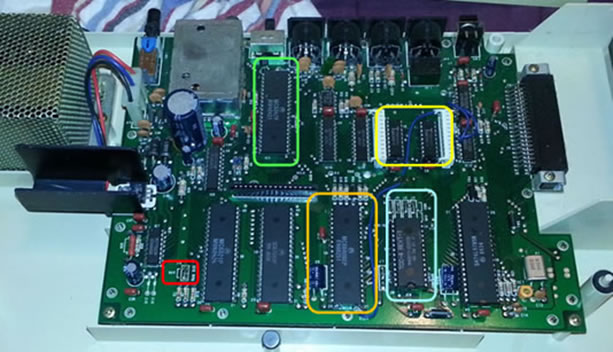
The Korean 26-3134A & 26-3136A
Above is what I believe to be the motherboard from a 26-3134A or 26-3136A CoCo2. Component placement is very different from the non A or B models (not to mention the American CoCo2s). This one has been upgraded to 64k using two TMM41464P DRAM chips. The case for this CoCo2 bears a sticker stating it’s a 26-3027. Component highlights:
- J1 ‘RAM SIZE’ jumper circled in red lower left
- MC68A09EP CPU circled in orange lower middle
- 28 pin ROM socket, configured for a 128k eprom circled in cyan just right of the CPU
- Jumpers for 128k eprom selection just above ROM socket
- DRAM chips circled in yellow middle of the board
- MC6847P VDG chip circled in green upper left next to the RF modulator shield
While the differences may appear to be pretty stark, mainly due to component location, there really isn’t much difference between the non A & B series and the A & B series 26-3134 & 3136.
To upgrade the memory in the 26-3134 & 3136, you swap out the eight 4116 DRAM chips with 4164 DRAMs, solder a jumper on the J1 ‘RAM SIZE’ pads near IC7.
To upgrade the memory in the 26-3134A& 3136B, you swap out the two 4416 DRAM chips near the white connectors with 4464 DRAMs, solder a jumper on the J1 ‘RAM SIZE’ pads near the MC6821P (which I think is IC7).
Incidentally, those two white connectors were supposed to be used for a future DRAM upgrade via daughter card. Prior to my digging my CoCo2’s out of my garage for this article, I’d been told of the 26-3127 CoCo2’s in the wild having these same motherboards with the white connectors. During all of my research, I’ve found one example of a commercial product that took advantage of them – and I own it. However, I understand the Aussie Radio Shacks usually upgraded their 16k CoCo2’s by use of a daughter card, this was more common there than in the states.
The Korean 26-3127
The Korean 26-3127 is identical to the American version. No difference. There’s also supposed to be a 26-3127A version; I’ve never actually seen one, but, that’s what my research has shown me thus far. However, there is a ‘B’ version of the Korean 26-3127 that deserves special mention. The 26-3127B CoCo2 is notable since some of these models used a different VDG; the MC6847T1. This allowed the CoCo2 to provide TRUE lowercase characters on screen.
While there are several ways to identify whether a 26-3127B CoCo2 will put true lowercase characters onscreen, just typing the ‘0’ (zero) character should tell you. If the 0 has a slash thru is, it’s the updated VDG chip and should be capable of lowercase characters. Or you could issue the following: POKE 359,57 then POKE &HFF22,&H10. That should get you true lowercase.
Wrapping it up
That’s it for this issue of ‘CoCoLicious!’. Writing the article was fun and informative. I know I didn’t cover every version of the CoCo2 in depth, and I apologize. However, I only own four of them, and there are several more that I can only read about. In closing, I hope everyone had a great Thanksgiving, and I wish you all a joyous and blessed holiday season. I’d like to give you some Christmas wishes from the next Color Computer I’ll be discussing – the Tandy Color Computer 3. Merry Christmas and a Happy New Year!!!

The above Christmas images were created by Jason Law
Sources for this article:
Sam’s Computerfacts CC15: Radio Shack TRS-880 Color Computer Models: 26-3134, 26-3136 – Howard W. Sams & Co.
Tandy’s Little Wonder – the Color Computer: 1980-1991 – Frank G. Swygert, Published by FARNA Systems
The Color Computer Mailing List Archives
Techno’s CoCo Site

